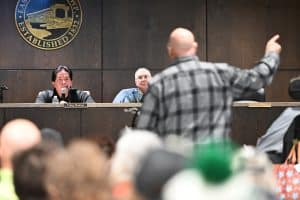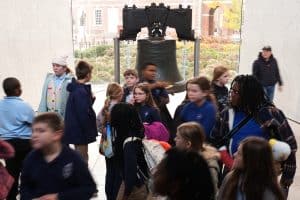Sarah Kendzior’s They Knew: How a Culture of Conspiracy Keeps America Complacent is a stark, sharply written, and disturbingly insightful account of why conspiracy belief is so prevalent in America today. The author is a self-declared “full-time prognosticator of doom—that is, a twenty-first-century realist.” (21) She offers the reader a chance to capture our 21st Century moment, in all its ugly glory. Referring to climate change, but using terms that apply to virtually every controversy in the last twenty years, Kendzior writes:
“The conversation was a suicidal fever dream, a post 9/11 embrace of death masked as defiance. That the so-called unimaginable had happened, America attacked on its own soil, then the rules of logic had to be obliterated in favor of rejecting more bad news. Reality TV, bubble economics, truthiness: the 21st Century operated on illusion, and the greatest illusion was that we still had time.” (103)
They Knew is indeed a dark ride.
In my classes, I am constantly on the lookout for authors best able to capture a particular moment in American history. Tom Wolfe was a reliable master of this art. For more recent times, I have leaned on Matt Taibbi, particularly The Great Derangement (2008), Griftopia (2011), and, more recently, Hate Inc. (2019). Kendzior follows this trajectory. She presides over a ruined, post-industrial, autocratic America. It is a place where elites combine for the sake of power and use an elaborate methodology to keep the vast majority of their victims – social, economic, and political — at bay.
They Knew is most effective when it dissects conspiracy theories as a deliberate practice. Kendzior focuses in particular on the weaponization of information for the sake of gaslighting an audience. Many practitioners are well known, Alex Jones, Steve Bannon, Tucker Carlson, Kellyanne Conway, and Donald Trump, although their chosen tools are not. One type of gaslighting that caught my attention was “preemptive narrative inversion.” (82) It involves a combination of projection and preemption that is extremely useful in keeping an opponent, be they an investigative journalist, a rival political party, or a concerned citizen, off balance and winning an argument. The “Stop the Steal” campaign is a case in point. Recent court documents reveal a concerted Republican effort to undercut the results of the 2020 election while the party carried on a media campaign accusing Democrats of the exact same action without any evidence. While responsible public officials painstakingly attempt to document good electoral practices, they are drowned out by a constant drumbeat of falsehoods. Dinesh D’Souza’s 2000 Mules is a case study in this practice.
Kendzior points out that within this environment, what defines a conspiracy theory can be “extraordinarily malleable.” (31) Claims made in good faith about ongoing CIA operations like MK Ultra or the abuses perpetrated by the FBI under COINTELPRO seemed like paranoid fantasies until proven by hard evidence. Even so, peoples’ desire and ability to believe the evidence still affects the distinction between tin-foil hat paranoia and good research.
READ: Can Education Solve Our Country’s Conspiracy Theory Problem?
The process of moving from conspiracy theory to conspiracy fact can be difficult and, in some cases, risky. It involves navigating through a mainstream media that “caters to power.” (133) It involves circumventing the doubts of experts vested in a status quo that preserves their privilege. It must traverse a social and political landscape where “an epidemic of disillusionment and distrust so vast it stretches into paralysis.” (16) Anyone seeking out the truth does so with distinct risks. Family relations might suffer. For professional journalists or historians, the quest might affect their livelihood. Finding the truth might be the worst outcome of all: “You plumb the depths, and then you drown in them.” (65)
Disillusionment is one of the main reasons that conspiracies have so deeply penetrated us. Kendzior attributes this increasingly fertile atmosphere to a systematic “breakdown of institutions and social trust.” (10) Everywhere we turn, it seems as if the old bastions of social order and stability – a spectrum covering everything from investigative media to transparent public institutions, to leaders vested in their constituents’ best interests — are breaking down before our very eyes. Kendzior notes that “there are few things more disconcerting than learning that the rescue crew is in on the plot.” (6)
Beyond disillusionment, there is also rage. In his excellent 2017 Insane Clown President, Matt Taibbi precisely identified the millions of Americans who gravitated to Trump and his message:
“These are the voters who’ve never met a New York billionaire, but they’ve sure met a lot of corporate middle managers and divorce lawyers and professors and other such often-overcompensated members of the intellectual class.” (xxiii)
You could easily add to this list a generation of corporate Republicans and Democrats who embraced bipartisanship for policies like NAFTA and then visited the burned-out cores of old manufacturing towns like Manchester, New Hampshire, during primary season in some absurd parody of democracy. It is the same cohort of national political leaders who have allowed millions to fall off Medicaid rolls in the aftermath of a pandemic. Anyone who has ever waited on hold for an insurance agent understands this rage better than any political ideology.
It is hard to have hope in this America. And yet I do. I will stipulate that money and power are significant barriers to accountability. Equal justice is a troublesome goal in America and has been throughout its history.
I would contest Kendzior’s argument within two events she talks about in They Knew. One is September 11th and its aftermath. Kendzior correctly chronicles official White House obstruction of the Graham Committee’s investigation of the attacks. Unfortunately, she does not include whistleblowers like Richard Clarke and Joseph Wilson, who openly and publicly challenged the Bush administration’s narrative. Within a very short period of time, official agencies like the CIA and Defense Intelligence Agency joined in dismantling official misinformation.
Public support for the Global War on Terror collapsed in short order. As historian Kathryn Olmsted notes in Real Enemies, the number of people who believed that Iraq was behind September 11th dropped from 69 percent in September 2003 to just 22 percent after the Graham Commission issued its findings in July 2004.
It also makes sense to consider a second development. Again, Kendzior is correct in her assessment of the Justice Department as a problematic barrier to the abuse of power by the powerful. And yet, the court system is another story. Between the 2020 election and the January 6th insurrection, dozens of hare-brained conspiracy theories promoted by Republicans and Trump’s own “elite strike force team” of lawyers (Jenna Ellis, Sydney Powell, and Rudy Giuliani) collapsed under the weight of basic evidentiary requirements before justices appointed by Democrats and Republicans. According to the Department of Justice, 594 pleaded guilty to federal charges as a result of their criminal actions during January 6th. Another 98 were convicted at trial. The January 6th Committee might not result in successful prosecutions, but the jury is literally out regarding the string of charges that have landed on the former administration and its acolytes.
There are some meaningful David and Goliath stories here. Rudy Giuliani – “America’s Mayor”— a one-time presidential candidate and someone with access to the highest reaches of power, has been brought down by two Georgia election workers. A local community in Bucks County, awash in hundreds of thousands of dollars in outside special interest money during its school board elections, could and did successfully fight back.
Kendzior was absolutely right when she wrote: “Democracy is a force of habit, and habits can be broken.” (156) I am worried about next year as are many Americans.
And yet, I have hope. Democracy depends on more than elites. It depends on us. As the saying goes, “There is no cavalry. We are the cavalry.”







